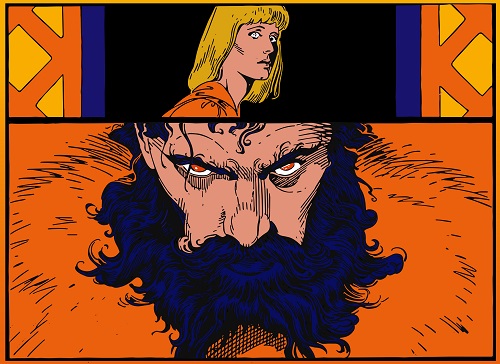 United States Dukas: TableTopOpera (Frederico Agostini, violin; David Ying, cello; James VanDemark, double bass; Griffin M. Campbell, alto sax; James Thompson, trumpet; Jackson Courtright, trombone; Albert Kim, Dariusz Terefenko, keyboards) / Mark Watters (conductor), Hoyt Hall Auditorium, University of Rochester, Rochester, 11.9.2018. (LV)
United States Dukas: TableTopOpera (Frederico Agostini, violin; David Ying, cello; James VanDemark, double bass; Griffin M. Campbell, alto sax; James Thompson, trumpet; Jackson Courtright, trombone; Albert Kim, Dariusz Terefenko, keyboards) / Mark Watters (conductor), Hoyt Hall Auditorium, University of Rochester, Rochester, 11.9.2018. (LV)

Paul Dukas (adapted) – Ariane and Bluebeard
Images by P. Craig Russell. Restorations by P. Craig Russell and Wayne Alan Harold
Score by Matthew Brown, Dariusz Terefenko, and Christopher Winders
Technology and sound design by Christopher Winders
Produced by Th. Emil Homerin and Matthew Brown
Directed by Christopher Winders and Matthew Brown
It was a night for lovers of Symbolist French opera and operatic comic books. A boys of summer team in Rochester, New York, called TableTopOpera, had presented their reductionist fantasy based on Arianne et Barbe-bleu by Paul Dukas of Sorcerer’s Apprentice fame.
For the 90 minutes of its one performance, the world’s greatest 8-member operatic comic book ensemble played a purely-instrumental adaptation of Dukas’s lush, iridescent score – seamlessly incorporating the occasional vocal passages that are not simply dialogue – while panels from P. Craig Russell’s graphic novel Ariane and Bluebeard, Op. 26 streaked, slashed, stalked, seduced, strode, and otherwise soared across the silver screen at the University of Rochester’s Hoyt Hall Auditorium.
Set against such a precisely brilliant deconstruction of the composer’s musical vision, Russell’s graphic novel tribute to Dukas’s Ariane recreated her anew as an authentically 21st century, androgynously indomitable force of cold, hard, radiant purity, moving inexorably through Russell’s storyboard towards her spectacular sunrise finale.
The show had opened with old-time silent movie credits then moved immediately into high gear as a horse-drawn carriage carrying Ariane rumbled through a medieval town over cobblestones, whipping its around corners on its way to Bluebeard’s castle, with Dukas’s music rippling and surging continuously underneath, as it would be all night. It was an intoxicating ride.
Many of the surges would be prolonged and gorgeous, and there would be frequent solo riffs on the main leitmotivs for all the members of the band: violin, cello, double bass, alto sax, trumpet, trombone, and two keyboards. As the sound mixed, amplified, and filled the room’s modest dimensions, it became Dukas at his peak: decadent, elegant, perfumed, French Wagnerian, urgent, lush.
It was an added plus for Ariane when the renowned film composer Mark Watters, newly hired as the first director of Eastman’s new Beal Institute for Film Music and Contemporary Media, signed on to conduct. Not only did he seemingly never miss a beat while providing signposts for the players, he understood perfectly the TableTop joy of patching together disparate elements of music, theater, and comic book type video, as if it were a garage band approach to classical music.
The score by Matthew Brown, Dariusz Terefenko, and Christopher Winders was a miracle of collaborative creation. All editing decisions were made in regard not only to Brown’s profound knowledge of the epoch and Russell’s passion for the opera, but of the demanding virtuosos who would be playing it, for the multimedia skills it would require – and for a strong commitment to the integrity of the original score. Brown, after all, is a professor of music theory at the Eastman School of Music, and his co-Table Top ringleader, Th. Emil Homerin, is a professor of religion at the University of Rochester.
TableTopOpera began in 2012 with a similar production of Debussy’s Pelléas et Mélisande and then moved on to Richard Strauss’s Salome a few years later; in between they produced shows focused on social justice. Last year it was Within The Quota, exploring Cole Porter’s “protest ballet” about the United States’ “Emergency Quota Act” of 1921.
In each of the three operas the musical decisions have always been tailored to the emotional content of the panels, rather than being mechanically synched to narrative or dialogue. It was not seamless Disney, it was real.
In the case of Ariane and Bluebeard Russell in his graphic novel version had already drilled so deeply down into the character of Ariane herself that she was ready to become a cinematic heroine as soon as time to mount the production permitted and the technology emerged. Watching Russell’s Ariane on the printed page dominate every panel of the visual narrative with her proud bearing and foreknowledge had already mined the glorious sadness infusing Dukas’s own hope for redemption; the TableTopOpera production intensified it.
Russell does not limit his focus to Ariane and draws the subsidiary characters with the same beautiful veracity. Bluebeard himself is a magnificent beast throughout, despite the fact that he has only a few words. And each of Bluebeard’s five wives is fascinating to look at whether flashing by in high vertical panels or in ensemble pieces on larger, full page panels. Alladine’s white arms and Mélisande’s red hair are focal points of Ariane’s interaction with the real world. Even the dialogue in the comic book bubbles connect on a personal level that is less remote than reading subtitles at the opera.
TableTopOpera’s next project is reported to be Stravinsky’s The Nightingale, and then their final production, Wagner’s Ring of the Nibelungen.
Laurence Vittes